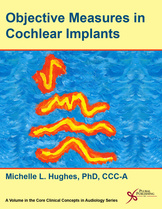Publication
Objective Measures in Cochlear Implants
- Details:
- 164 pages, Illustrated (B/W), Softcover, 8.5 x 11"
- ISBN13:
- 978-1-59756-435-9
- Release Date:
- 07/13/2012
Overview
Clinically-oriented, Objective Measures in Cochlear Implants begins with a clear description of the underlying basic science and signal characteristics of objective measures made with cochlear implants. Divided into three parts, this book covers basic science, non-physiological objective measures, and physiological measures.
There are very few books about evoked potentials and objective measures in cochlear implants, making this a great resource for audiology graduate students or seasoned audiologists with little cochlear implant experience.
Reviews
Y Ramakrishnan, The Journal of Laryngology & Otology:
"The author and editors have done a superb job with this book. What I particularly liked was that it is pitched perfectly both for those with little cochlear implant experience and for more experienced readers who would like an overview of the subject.
For those from an ENT background, the detailed audiological measures related to cochlear implants have traditionally been seen as the domain of audiological scientists. What this book does is to invite the inexperienced reader to understand the basic science, non-physiological objective measures and physiological measures, in a very simplistic manner. Various figures are used to illustrate concepts and results in each chapter, adding to the overall readability of the book. Key concepts are also summarised at the end of every chapter.
I feel this book is a great reference to have. [I]t is a must for those who truly want to understand more about cochlear implants."Annie Woolley, Clinical Scientist, Yorkshire Auditory Implant Service, Bradford Teaching Hospitals NHS Foundation Trust, UK, ENT and Audiology News (July/August 2016):
"Each chapter has been kept relatively short and easily digestible, making it a quick reference for a busy clinician, but content has not been compromised and references are provided for those wishing to look further into the research that the author has synthesized on the reader's behalf. A particular strength of the book is the clear diagrams that are included throughout. The price of this book compares favorably with other specialist books in the field and may be considered a worthwhile investment."
Foreword by Series Editors Terry Zwolan and Jace Wolfe vii
Preface ix
Acknowledgments x
About the Author xi
PART I. LAYING THE FOUNDATION 1
- 1 The Basics of a Cochlear Implant 3
- Introduction 3
Anatomy of Severe to Profound Hearing Loss 4
Basic Principles of Electrical Stimulation of the Auditory System 7
Basic Parts and Functions of a Cochlear Implant 8
Past and Present Devices 12
Candidacy 27
- Introduction 3
- 2 Signal Delivery 31
- Channels Versus Electrodes 31
Signal Type 34
Stimulus Timing 36
Electrode Configuration 37
Electrode Design 40
Summary 41
- Channels Versus Electrodes 31
PART II. NONPHYSIOLOGICAL OBJECTIVE MEASURES 43
- 3 Electrode Impedance 45
- Introduction 45
The Basics of Electrode Impedance 45
How Impedance Is Measured Clinically 54
Clinical Uses for Impedance Measures 62
Summary 64
- Introduction 45
- 4 Electrical Field Potentials 67
- Basic Description 67
Measurement 69
Clinical Uses for Electrical Field Potentials 69
Summary 72
- Basic Description 67
- 5 Averaged Electrode Voltages 75
- Basic Description 75
Measurement 75
Factors Affecting AEV Measures 78
Typical Patterns 78
Atypical Patterns 84
Clinical Uses for AEVs 86
Summary 90
- Basic Description 75
PART III. PHYSIOLOGICAL OBJECTIVE MEASURES 91
- 6 Electrically Evoked Stapedial Reflexes 93
- Introduction to Physiological Objective Measures 93
Basic Description 93
Measurement 94
Clinical Uses for ESRTs 95
Summary 98
- Introduction to Physiological Objective Measures 93
- 7 Electrically Evoked Compound Action Potential 101
- Basic Description 101
Measurement 102
Clinical Uses for ECAPs 118
Summary 121
- Basic Description 101
- 8 Electrically Evoked Auditory Brainstem Response 123
- Basic Description 123
Measurement 124
Clinical Uses for EABRs 130
Summary 131
- Basic Description 123
- 9 Electrically Evoked Auditory Middle Latency Response 133
- Basic Description 133
Measurement 135
Clinical Uses for EAMLRs 136
Summary 136
- Basic Description 133
- 10 Electrically Evoked Auditory Cortical Potentials 139
- Introduction 139
Electrically Evoked Auditory Late Response 140
Electrically Evoked Acoustic Change Complex 144
Mismatch Negativity 146
P300 Response 148
Summary 149
- Introduction 139
References 151
Index 161
About The Author
Dr. Michelle Hughes is the Coordinator of the Cochlear Implant Program and Director of the Cochlear Implant Research Laboratory at Boys Town National Research Hospital in Omaha, Nebraska. She is also an adjunct assistant professor in the Department of Special Education and Communication Disorders at the University of Nebraska-Lincoln. Her NIH-funded research program is aimed at investigating the relationships between physiological and perceptual measures in cochlear implant recipients. She has published numerous peer-reviewed journal articles on evoked potentials in cochlear implants, and has presented her work nationally and internationally.
Related Title
Cochlear Implants
Edited by: Betty Loy, Peter Roland
200 pages, Illustrated (B/W), Softcover, 6 x 9"










